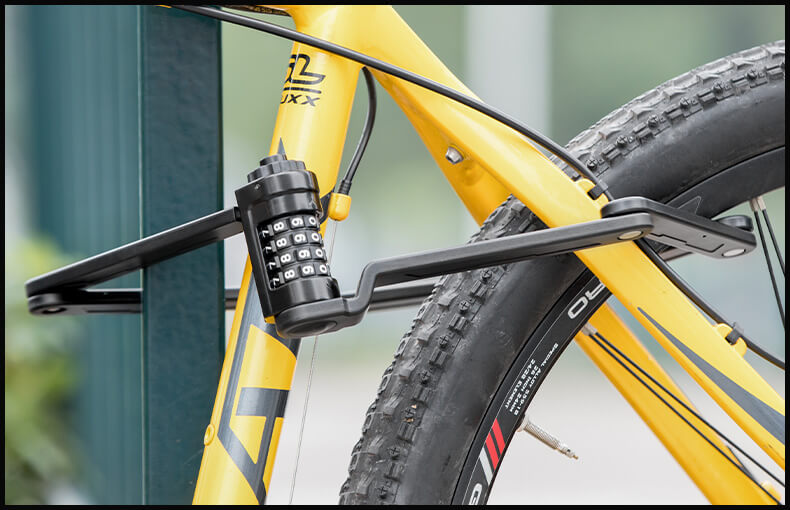Riding a bike is not just a means of transportation; it’s a lifestyle choice, a passion, and a form of exercise. Whether you’re a casual cyclist or a dedicated rider, the last thing you want is to have your bike stolen. Bike theft is a growing concern, and it’s essential to equip yourself with the knowledge and tools necessary to keep your prized possession safe. In this guide, we’ll take you on a journey to master the art of bike security and provide you with the ultimate guide to locking your bike safely.
Choosing the Right Lock – Protecting Your Bike Fortress
Your bike lock is the first line of defense against thieves. Here are five types of locks to consider:
- U-Locks: The Heavyweight Champion of Security
- Exploring the unyielding strength of U-locks and their robust construction
- Tips on choosing the right size and material for maximum security
- Chain Locks: The Versatile and Portable Solution
- Unlocking the potential of chain locks and their flexibility in various situations
- Understanding the importance of link thickness and length
- Folding Locks: Compact Yet Secure
- Discovering the convenience and reliability of folding locks
- Examining the different designs and their unique features
- Cable Locks: Lightweight, But Use with Caution
- Unveiling the pros and cons of cable locks and their suitability for low-risk areas
- Combining cable locks with other locking mechanisms for enhanced security
- Smart Locks: Embracing Technology for Added Protection
- Embracing the future with smart locks and their advanced features
- Exploring keyless entry, GPS tracking, and remote locking capabilities

Locking Techniques – Guarding Your Two-Wheeled Companion
Now that you’ve chosen the perfect lock, it’s time to master the art of locking your bike effectively. Here are five essential techniques:
- Secure Frame and Wheel: Double the Protection
- Understanding the importance of securing both the frame and wheels
- Utilizing proper locking techniques to prevent partial theft
- Fixed Objects: Anchor Your Bike’s Safety
- Identifying secure fixed objects and how to properly lock your bike to them
- Avoiding easily removable objects and potential dangers
- High-Traffic Areas: Crowds for Safety
- Recognizing the advantages of locking your bike in high-traffic areas
- Minimizing the risk of theft with the power of witnesses
- Additional Accessories: Fortify Your Bike’s Defenses
- Exploring supplementary accessories to enhance your bike’s security
- Utilizing wheel and seat locks, skewers, and alarms for added protection
- Overnight Storage: Protecting Your Bike While You Sleep
- Preparing for overnight bike storage and choosing secure locations
- Considering indoor storage, bike shelters, and secure parking options
Where to lock your bike in the street:
- choose a busy area with CCTV
- lock your bike in the middle of lots of other bikes
- always secure your bike to a fixed, immovable object, ideally a bike rack
- don’t lock your bike outside places you’ll clearly be for a long time
- if you know it’s a high theft risk area, take an extra lock
how to lock your bike in the street:
- always lock the frame (not just the wheel!) to the secure object
- keep the lock as far from the ground as possible
- but avoid locking around the top tube
- make the lock as difficult to access as possible
- if you use a u-lock fill as much of the internal space as possible
Lock Maintenance – Keep Your Lock in Peak Condition
Just as your bike requires maintenance, so does your bike lock. Follow these simple steps to keep your lock functioning optimally:
- Cleaning and Lubrication: Removing Dirt and Rust
- Regular Inspections: Checking for Wear and Tear
- Combination Change: Keeping Thieves on Their Toes
- Proper Storage: Protecting Your Lock When Not in Use
Extra tips
- More than half of all bike thefts are from the owners’ property. At home, if you have space in your house, keep your bikes locked inside. If you use a shed or a garage, consider using a floor or wall-mounted anchor lock for extra security. A battery-operated alarm for your shed is also a good idea to deter thieves. Buy a decent lock for your shed, one that can’t just be unscrewed with a screwdriver.
- You’ll need to oil the lock occasionally to prevent it seizing. Squirt a bit of oil into any holes and work it in by repeatedly opening and closing the lock. If your lock freezes solid in winter, pour hot water over it and oil it afterwards.
- Consider etching your postcode onto your bike frame.
- If you can, remove the saddle and take it with you, as these also appear fair game – with leather Brooks saddles proving very popular with thieves. If you’re not keen on looping an extra cable through the stays every time you lock your wheels, then a tactic employed by some is to create a permanent anchor from saddle to frame with an old bike chain fed through an inner tube.
- Take photographs of the bike, including any distinctive marks or features on it.
Mastering the art of locking your bike is not just about preventing theft; it’s about protecting your investment and preserving your cycling passion. By choosing the right lock, employing effective locking techniques, and maintaining your lock’s condition, you can enjoy peace of mind every time you leave your bike unattended. Remember, bike security is a responsibility we all share, so spread the knowledge and encourage others to protect their two-wheeled companions.
Remember, the joy of cycling comes from the freedom and peace of mind that your bike is safe and secure. Don’t let the fear of theft hinder your cycling adventures. With the right lock, techniques, and awareness, you can confidently explore the world on two wheels without a worry. So gear up, lock up, and pedal on!
 hotebike
hotebike